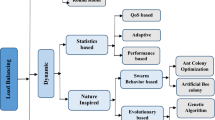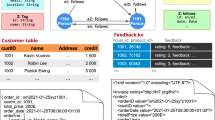Abstract
With an increasing number of scientific workflows accessible on public repositories, the mechanism for discovering and recommending workflow fragments is important to facilitate the reuse and repurposing of legacy workflows when novel workflows are to be constructed, where dependencies among workflow activities, which implies functional patterns with different types and characteristics, are specified in the specification of workflows. Traditional approaches ignore or seldom consider this aspect, which may have certain influence on the quality of personalized recommendation. To address this challenge, this paper proposes a novel workflow fragment discovery mechanism for personalized requirements, where discovery strategies of basic and personalized patterns are presented independently. Specifically, frequent basic subfunctions are discovered from scientific workflows by applying the frequent subgraph mining algorithm. Similar subfunctions are clustered considering their semantic relevance of topics, and clusters with high functional frequency are assumed as basic patterns. Thereafter, the multi-dimensional representation of scientific workflows is constructed to explore workflow relevance. Workflow clustering is conducted, and frequent personalized functions are discovered from clusters with similar workflows and assumed as personalized patterns under respective contents. For a personalized requirement given in terms of a workflow template, target basic patterns and candidate subfunctions are discovered, and they compose the backbone structure of solution in a novel coverage strategy. Candidate personalized patterns are applied to cover remaining functionalities of requirement. An optimal solution is obtained through atomic service optimization. Evaluation results show that this technique is accurate on discovering fragment solutions for personalized requirements in comparison with the state-of-the-art techniques.








Similar content being viewed by others
References
Zheng Z, Ma H, Lyu MR, King I (2010) Qos-aware web service recommendation by collaborative filtering. IEEE Trans Serv Comput 4(2):140–152
Lin W, Dou W, Luo X, Chen J (2011) A history record-based service optimization method for qos-aware service composition. In: IEEE international conference on web services, pp 666–673
Lemos AL, Daniel F, Benatallah B (2016) Web service composition: a survey of techniques and tools. ACM Comput Surv (CSUR) 48(3):33
Zhou Z, Cheng Z, Zhang L-J, Gaaloul W, Ning K (2018) Scientific workflow clustering and recommendation leveraging layer hierarchical analysis, vol 11
Wen J, Zhou Z, Shi Z, Wang J, Duan Y, Zhang Y (2018) Crossing scientific workflow fragments discovery through activity abstraction in smart campus. IEEE Access 6:40530–40546
Goble CA, Bhagat J, Aleksejevs S, Cruickshank D, Michaelides D, Newman D, Borkum M, Bechhofer S, Roos M, Li P (2010) Myexperiment: a repository and social network for the sharing of bioinformatics workflows. Nucleic Acids Res 38(suppl_2):W677–W682
Garijo D, Alper P, Belhajjame K, Corcho O, Gil Y, Goble C (2014) Common motifs in scientific workflows: an empirical analysis. Futur Gener Comput Syst 36(3):338–351
Eshuis R, Lecue F, Mehandjiev N (2016) Flexible construction of executable service compositions from reusable semantic knowledge. ACM Trans Web 10(1):5
Tut MT, Edmond D (2002) The use of patterns in service composition. In: International workshop on web services, e-business, and the semantic web. Springer, pp 28–40
Melloul L, Fox A (2004) Reusable functional composition patterns for web services. In: IEEE international conference on web services, pp 498–505
Wang X, Niu W, Li G, Yang X, Shi Z (2012) Mining frequent agent action patterns for effective multi-agent-based web service composition. In: Agents and data mining iteration, pp 211–227
Zhang M, Zhang B, Na J, Zhang X (2009) Composite service selection based on dot pattern mining. In: SERVICES-I, pp 740–746
Upadhyaya B, Tang R, Zou Y (2013) An approach for mining web service composition patterns from execution logs. Journal of Software: Evolution and Process 25(8):841–870
Huang Z, Huai J, Liu X, Zhu J (2010) Business process decomposition based on service relevance mining. In: International Conference on Web Intelligence and Intelligent Agent Technology, pp 573–580
Yan X, Han J (2002) gspan: Graph-based substructure pattern mining. In: IEEE international conference on data mining, pp 721–727
Cheng X, Yan X, Lan Y, Guo J (2014) Btm: Topic modeling over short texts. IEEE Trans Knowl Data Eng 26(12):2928–2941
Blei D, Ng A, Jordan M (2003) Latent dirichlet allocation. Machine Learning Reasearch, pp 933–1022
Blondel VD, Guillaume J-L, Lambiotte R, Lefebvre E (2008) Fast unfolding of communities in large networks. J Stat Mech: Theory Exp 2008(10):155–168
Kim D, Seo D, Cho S, Kang P (2019) Multi-co-training for document classification using various document representations: Tf–idf, lda, and doc2vec. Inf Sci 477:15–29
Liu J, Jiang J, Cui X, Yang W, Liu X (2015) Power consumption prediction of web services for energy-efficient service selection. Pers Ubiquit Comput (PUC) 17(7):1063–1073
Chen J, Zhou X, Jin Q (2013) Recommendation of optimized information seeking process based on the similarity of user access behavior patterns. Pers Ubiquit Comput (PUC) 17(8):1671–1681
Hu H, Han Y, Huang K, Li G, Zhao Z (2004) A pattern-based approach to facilitating service composition. In: Grid and cooperative computing workshops, pp 90–98
Daniel F, Rodriguez C, Chowdhury SR, Nezhad HRM, Casati F (2012) Discovery and reuse of composition knowledge for assisted mashup development. In: International conference companion on world wide web, pp 493–494
Rodriguez-Mier P, Mucientes M, Lama M (2015) Hybrid optimization algorithm for large-scale qos-aware service composition. IEEE Trans Serv Comput 10(4):547–559
Deng S, Wang D, Li Y, Cao B, Yin J, Wu Z, Zhou M (2016) A recommendation system to facilitate business process modeling. IEEE Transactions on Cybernetics 47(6):1380–1394
Bevilacqua L, Furno A, Di Carlo VS (2011) E. zimeo, “compositions from owl-s described services. In: IEEE international conference on software, knowledge information, industrial management and applications (SKIMA) Proceedings. IEEE, pp 1–8
Bie R, Mehmood R, Ruan S, Sun Y, Dawood H (2016) Adaptive fuzzy clustering by fast search and find of density peaks. Pers Ubiquit Comput (PUC) 20(5):785–793
Verkasalo H (2009) Contextual patterns in mobile service usage. Pers Ubiquit Comput (PUC), 13(5):331–342
Thomas LT, Valluri SR, Karlapalem K (2010) Margin: Maximal frequent subgraph mining. ACM Trans Knowl Discov Data (TKDD) 4(3):10
Chaoji V, Hasan MA, Salem S, Zaki MJ (2008) An integrated, generic approach to pattern mining: data mining template library. Data Min Knowl Disc 17(3):457–495
Elseidy M, Abdelhamid E, Skiadopoulos S, Kalnis P (2014) Grami: frequent subgraph and pattern mining in a single large graph. Proceedings of the Vldb Endowment 7(7):517–528
Teixeira CH, Fonseca AJ, Serafini M, Siganos G, Zaki MJ, Aboulnaga A (2015) Arabesque: a system for distributed graph mining. In: The 25th symposium on operating system principles. ACM, pp 425–440
Inokuchi A, Washio T, Motoda H (2000) An apriori-based algorithm for mining frequent substructures from graph data. In: European conference on principles of data mining & knowledge discovery, pp 13–23
Kuramochi M, Karypis G (2001) Frequent subgraph discovery. In: IEEE International Conference on Data Mining, pp 313–320
Worlein M, Meinl T, Fischer I, Philippsen M (2005) A quantitative comparison of the subgraph miners mofa, gspan, ffsm, and gaston. In: European conference on principles & practice of knowledge discovery in databases, pp 392–403
Huan J, Wang W, Prins J (2003) Efficient mining of frequent subgraphs in the. In IEEE international conference on data mining. IEEE, pp 549–552
Author information
Authors and Affiliations
Corresponding authors
Additional information
Publisher’s note
Springer Nature remains neutral with regard to jurisdictional claims in published maps and institutional affiliations.
This work was supported by the National Natural Science Foundation of China (Grant nos. 61772479 and 61662021).
Rights and permissions
About this article
Cite this article
Wen, J., Zhou, Z., Lei, F. et al. Basic and personalized pattern-based workflow fragments discovery. Pers Ubiquit Comput 25, 1091–1111 (2021). https://doi.org/10.1007/s00779-019-01276-3
Received:
Accepted:
Published:
Issue Date:
DOI: https://doi.org/10.1007/s00779-019-01276-3




